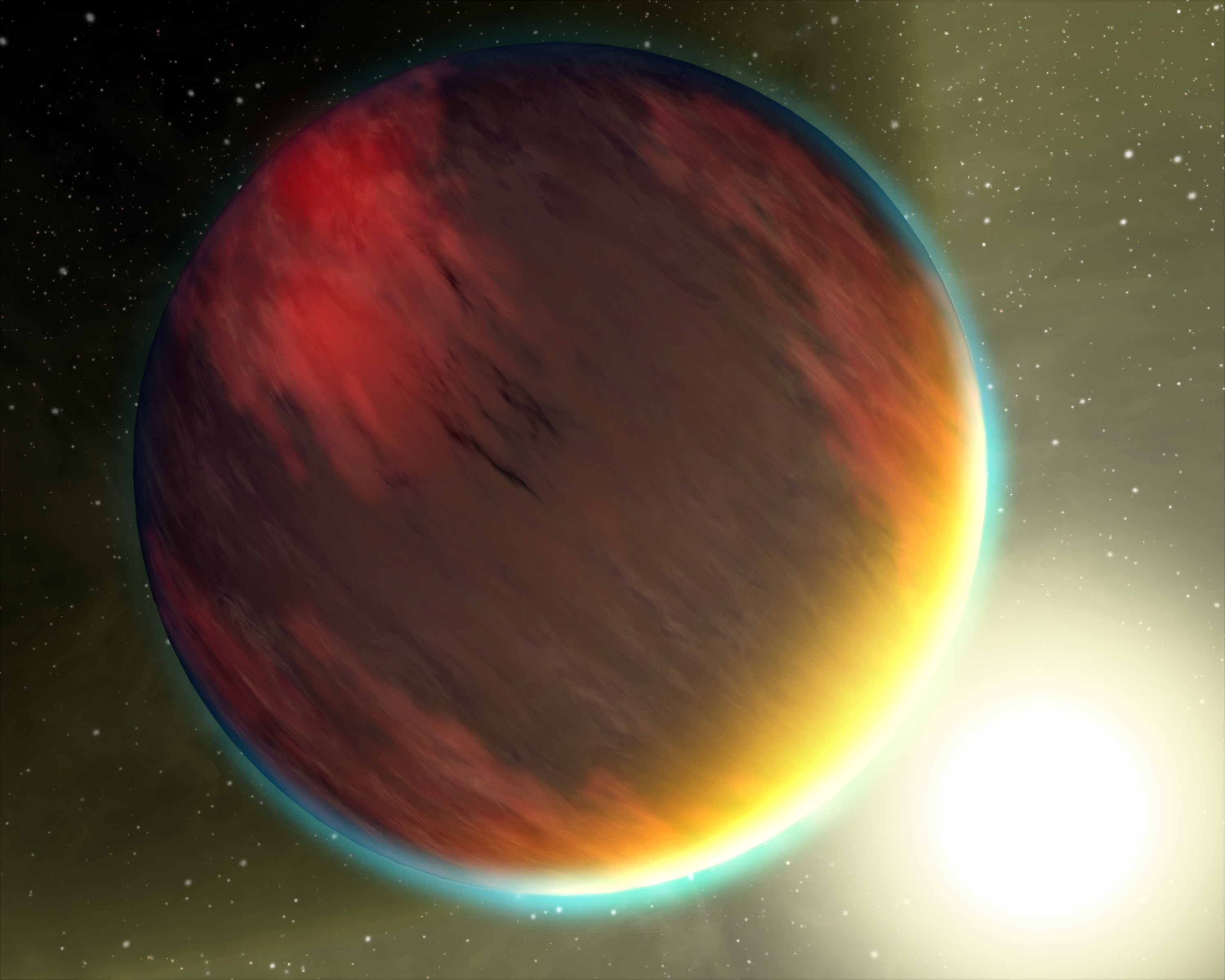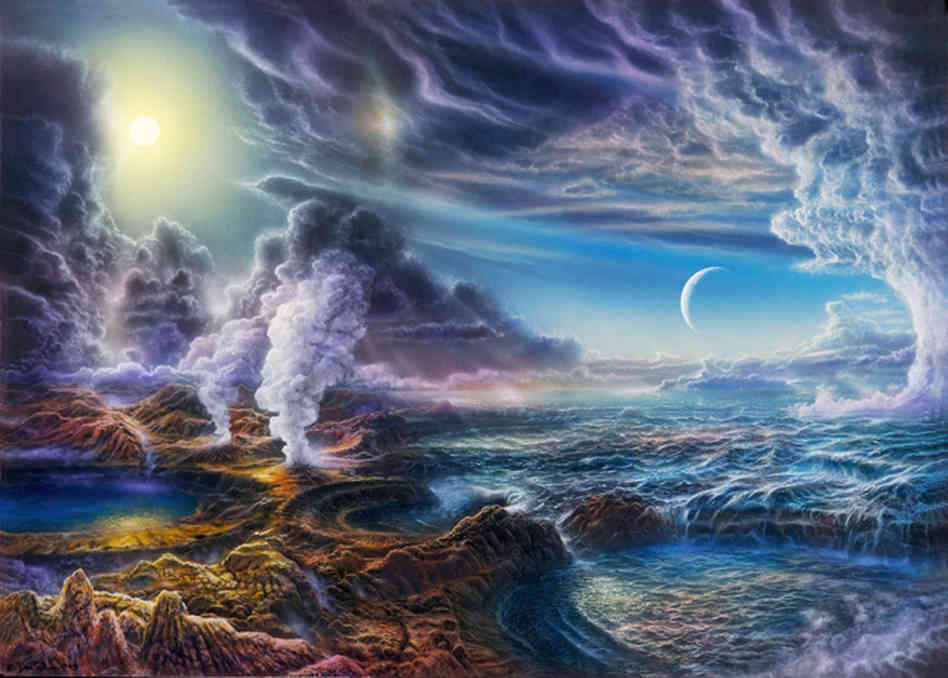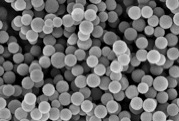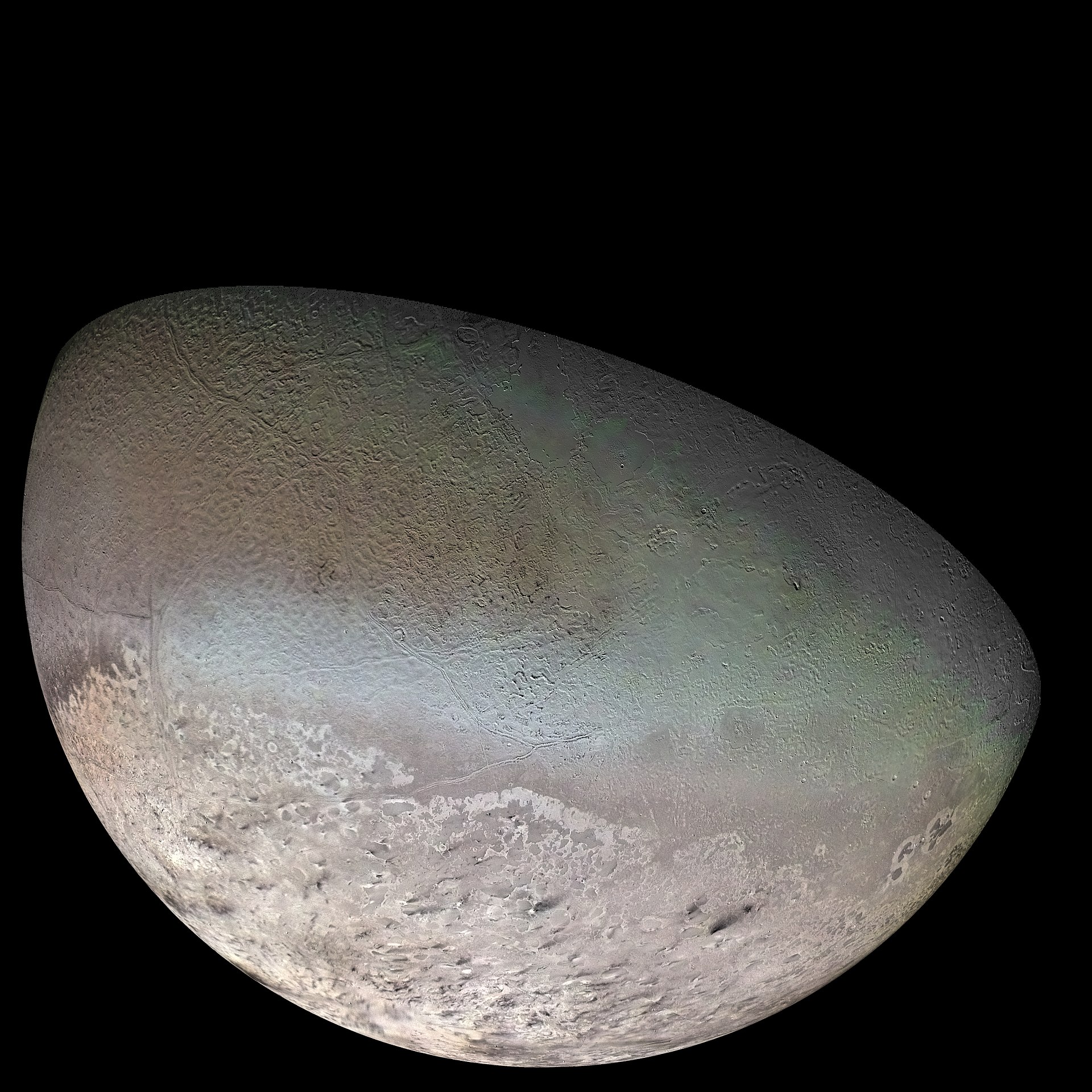



Titan is unique in the solar system; it is the only satellite with a substantial atmosphere and its atmosphere is both strongly reducing and contains significant quantities of carbon (CH4), nitrogen (N2) and oxygen (CO). Photochemistry in Titan’s atmosphere is therefore able to create complex molecules containing C, N, O and H. This makes Titan our only planetary-scale laboratory to study the synthesis of complex organic molecules. Through the use of photochemical modeling and laboratory atmosphere simulation experiments, I try to improve our understanding of Titan's atmosphere.
Barnes, J.W., Turtle, E.P., Trainer, M.G., Lorenz, R.D., MacKenzie, S.M., Brinckerhoff, W.B., Cable, M.L., Ernst, C.M., Freissinet, C., Hand, K.P., Hayes, A.G., Hörst, S.M., Johnson, J.R., Karkoschka, E., Lawrence, D.J., Le Gall, A., Lora, J.M., McKay, C.P., Miller, R., Murchie, S.L., Neish, C.D., Newman, C.E., Nuñez, J., Panning, M.P., Parsons, A.M., Peplowski, P.N., Quick, L.C., Radebaugh, J., Rafkin, Scot C.R., Ravine, M.A., Shiraishi, H., Soderblom, J.M, Sotzen, K., Stickle, A.M., Stofan, E.R., Szopa, C., Tokano, T., Wagner, T., Wilson, C., Yingst, R.A., Zacny, K., and S.C. Stähler. " Science Goals and Objectives for the Dragonfly Titan Rotocraft Relocatable Lander." Planetary Science Journal, 2:4, doi:10.3847/PSJ/abfdcf, 2021.
MacKenzie, S.M., Birch, S.P.D., Hörst, S.M., Sotin, C., Barth, E., Lora, J.M., Trainer, M.G., Corlies, P., Malaska, M.J., Sciamma-O’Brien, E., Thelen, A.E., Turtle, E., Radebaugh, J., Hanley, J., Solomonidou, A., Newman, C., Regoli, L., Rodriguez, S., Signovert, B., Hayes, A.G., Journaux, B., Steckloff, J., Nna-Mvondon, D., Cornet, T., Palmer, M., Lopes, R.M.C., Vinatier, S., Lorenz, R., Nixon, C., Czaplinski, E., Barnes, J.W., Sitttler, E., and A. Coates. "Titan: Earth-like on the Outside, Ocean World on the Inside." Planetary Science Journal, 2:3, doi:10.3847/PSJ/abf7c9, 2021.
Corlies, P.M., McDonald, G.D., Hayes, A.G., Wray, J.J., Ádámkovics, M., Malaska, M.J., Cable, M.L., Hofgartner, J.D., Hörst, S.M., Liuzzo, L.R., Buffo, J.J., Lorenz, R.D., and E. Turtle. " Modeling transmission windows in Titan’s lower troposphere: Implications for infrared spectrometers aboard future aerial and surface missions." Icarus, 357, 114228, doi:10.1016/j.icarus.2020.114228, 2021.
Benkoski, J.J., Luedeman, W.L., Teehan, J.O., Hörst, S.M., *He, C., and R.D. Lorenz. "Dust-Repellant Coatings for Optics under Simulated Titan Conditions. " Planetary and Space Science. 179, 104721, doi:10.1016/j.pss.2019.104721, 2019.
Hörst, S.M. "Titan's atmosphere and climate " JGR Planets, 122, 3, 432-482, doi:10.1002/2016JE005240, 2017. (Invited review for the 25th anniversary issue of JGR Planets)
Parker, A.H., Hörst, S.M., Ryan, E.L, and C.J.A. Howett. "k-Means Aperture Optimization Applied to Kepler K2 Time Series Photometry of Titan." Publications of the Astronomical Society of the Pacific, 131:084505, https://doi.org/10.1088/1538-3873/ab28ad, 2019.
Photochemical modeling

Photochemical models are powerful tools to increase our understanding of the complex chemical processes that occur in planetary atmospheres. They are particularly important for using composition measurements to understand the formation and evolution of a planet's atmosphere. In Titan's atmosphere, we have shown that the three oxygen bearing species that have been detected (carbon monoxide, carbon dioxide, and water) are the result of external sources of oxygen (O+ and H2O), which most likely originate in the plumes of Enceladus.
Vuitton, V., Yelle, R.V., Klippenstein, S.J., Hörst, S.M.., and P. Lavvas. "Simulating the density of organic species in the atmosphere of Titan with a coupled ion-neutral photochemical model." Icarus, 324, 120-197, doi: 10.1016/j.icarus.2018.06.013, 2019.
Hörst, S.M., Vuitton, V. and R.V. Yelle. "Origin of oxygen species in Titan’s atmosphere." J. Geophys. Res. 113, E10, E10006, doi:10.1029/2008JE003135, 2008. (Research Highlight in Nature Geoscience)
Yelle, R.V., Vuitton, V., Lavvas, P., Klippenstein, S.J., Smith, M.A., Hörst, S.M., and J. Cui. "Formation of NH3 and CH2NH in Titan’s upper atmosphere." Faraday Discussion, 147, doi:10.1039/C004787M, 2010.
Titan Atmosphere Simulation Experiments

Although Titan is our best planetary-scale laboratory to study organic chemistry, we often need to use laboratories here on Earth to further our understanding of the formation and composition of haze particles in Titan's atmosphere. These Titan simulation experiments subject Titan relevant gas mixtures to various energy sources (UV, plasma, etc.) that initiate chemistry that results in the formation of Titan aerosol analogues, or "tholins". Through these experiments, we've shown that the building blocks of life, things like nucleotide bases and amino acids, may be present in Titan's atmosphere. We've also recently demonstrated that some of Titan's haze particles may float in Titan's rivers and seas.
*He, C., *Serigano, J., Hörst, S.M., *M. Radke, and J.A. Sebree. " Titan Atmospheric Chemistry Revealed by N2-CH4 Plasma Discharge Experiments." ACS Earth and Space Chemistry, 6, 2295-2304, doi:10.1021/acsearthspacechem.2c00164, 2022.
*He, C., Hörst, S.M. , *Radke, M., and M. Yant. " Optical Constants of Titan Haze Analogue from 0.4 to 3.5 um: Determined Using Vacuum Spectroscopy." Planetary Science Journal, 3:25, doi:10.3847/PSJ/ac4793, 2022.
Li, J., Yu, X., Sciamma-O’Brien, E., †He, C., Sebree, J.A., Salama, F., Hörst, S.M. , and X. Zhang. "A Cross-Laboratory Comparison Study of Titan Haze Analogs: Surface Energy." Planetary Science Journal, 3:2, doi: 10.3847/PSJ/ac3d27, 2022.
*Yu, X., Hörst, S.M. ,, *He, C., McGuiggan, P., Kristiansen, K., and X. Zhang. "Surface Energy of the Titan Aerosol Analog “Tholin”" Astrophysical Journal, 905, 88, doi:10.3847/1538-4357/abc55d, 2020.
Wolters, C., Flandinet, L., *He, C., Isa, J., Orthous-Daunay, F.-R., Thissen, R., Hörst, S.M., and V. Vuitton. "Enhancing data-acquisition for the analysis of complex organic matter in direct infusion Orbitrap mass spectrometry by using microscans." Rapid Communications in Mass Spectrometry, 34, e8818, doi: 10.1002/rcm.8818, 2020.
Sebree, J.A., Shipley, E., Roach, M., *He, C. and S.M. Hörst . "Detection of prebiotic molecules in aerosol analogs using GC/MS/MS techniques." Astrophysical Journal, 865, 133, doi: 10.3847/1538-4357/aadba1, 2018.
Hörst, S.M., Yoon, Y.H., Ugelow, M.S., Parker, A.H., Li, R., de Gouw, J., and M.A. Tolbert. "Laboratory Investigations of Titan Haze Formation: In Situ Measurement of Gas and Particle Composition." Icarus, 301, 136-151, doi: 10.1016/j.icarus.2017.09.039, 2018.
He, C.*, Hörst, S.M., Riemer, S.*, Sebree, J.A., Pauley, N., and V. Vuitton. "Carbon Monoxide Affecting Planetary Atmospheric Chemistry." Astrophysical Journal Letters, 841: L31, doi:10.3847/2041-8213/aa74cc, 2017.
Cable, M.L., Hörst, S.M., He, C., Stockton, A.M., Mora, M.F., Tolbert, M.A., Smith, M.A., and P.A., Willis. "Identification of Primary Amines in Titan Tholins using Nonaqueous Microchip Capillary Electrophoresis." Earth and Planetary Science Letters, 403, 99-107, doi:10.1016/j.epsl.2014.06.028, 2014.
Yoon, Y.H., Hörst, S.M., Hicks, R.K., Li, R., J.A. deGouw, and Tolbert, M.A. "The Role of Benzene Photolysis in Titan Haze Formation." Icarus, 233, 233-241, doi:10.1016/j.icarus.2014.02.006, 2014.
Hörst, S.M., and M.A. Tolbert, "The Effect of Carbon Monoxide on Planetary Haze Formation." Astrophysical Journal, 781, 53, doi:10.1088/0004-637X/781/1/53, 2014.
Hörst, S.M. and M.A. Tolbert. "In Situ Measurements of the Size and Density of Titan Aerosol Analogues." Astrophysical Journal Letters , 770, L10, doi:10.1088/2041-8205/770/1/L10, 2013.
Hörst,
S.M., Yelle, R.V., Buch, A., Carrasco, N., Cernogora, G., Dutuit, O., Quirico, E., Sciamma-O’Brien, E., Smith, M.A., Somogyi, A., Szopa, C., Thissen, R., and Vuitton, V. "Formation of Amino Acids and Nucleotide Bases in a Titan Atmosphere Simulation Experiment." Astrobiology, 12, 9, doi: 10.1089/ast.2011.0623, 2012. (Featured on the cover)
This is a copy of an
article published in
Astrobiology © 2012
copyright Mary Ann Liebert,
Inc.; Astrobiology is
available online at: http://online.liebertpub.com
Cable, M.L.,
Hörst,
S.M., Hodyss,
R.P., Beauchamp, P.M.,
Smith, M.A., and Willis,
P.A. "Titan Tholins:
Simulating Titan Organic
Chemistry in the Post
Cassini-Huygens Era."
Chemical
Reviews, 112, (3),
1882-1909, 2012.
This is a copy of an article published in Astrobiology © 2012 copyright Mary Ann Liebert, Inc.; Astrobiology is available online at: http://online.liebertpub.com
Titan's Surface
Comola, F., Kok, J.F., Lora, J.M, Cohanim, K., Yu, X., *He, C., McGuiggan, P., Hörst, S.M. , and F. Turney. "Titan’s Prevailing Circulation Might Drive Highly Intermittent, Yet Significant Sediment Transport." Geophysical Research Letters, 49, e2022GL097913. doi:10.1029/2022GL097913, 2022.
*Yu, X., Hörst, S.M., *He, C., and P. McGuiggan. "Single Particle Triboelectrification of Titan Sand Analogs." Earth and Planetary Science Letters, 530, 115996, doi:10.1016/j.epsl.2019.1159967, 2020.
*Yu, X., Hörst, S.M., *He, C., Crawford, B., and P. McGuiggan. "Where does Titan sand come from: Insights from mechanical properties of Titan sand candidates." JGR-Planets, doi:10.1029/2018JE005651, 2018.
Yu, X.*, Hörst, S.M.., He, C.*, McGuiggan, P., and N.T. Bridges. "Direct Measurement of Interparticle Forces of Titan Aerosol Analogs (Tholin) Using Atomic Force Microscopy." JGR Planets, 122, doi: 10.1002/2017JE005437, 2017.
Yu, X*, Hörst, S.M., He, C.*, Bridges, N.T., Burr, D.M., Sebree, J.A., and Smith, J.K. "The Effect of Adsorbed Liquid and Material Density on Saltation Threshold: Insight from Laboratory and Wind Tunnel Experiments." Icarus, 297, 97-109, doi:10.1016/j.icarus.2017.06.034, 2017.
Lunine, J.I., and S.M. Hörst. "Organic chemistry on the surface of Titan." Rend. Fis. Acc. Lincei, 22:183–189, doi:10.1007/s12210-011-0130-8, 2011.
Wall, S.D., Lopes, R.M., Stofan, E.R., Wood, C.A., Radebaugh, J.L., Hörst, S.M., Stiles, B.W., Nelson, R.M., Kamp, L.W., Janssen, M.A., Lorenz, R.D., Lunine, J.I., Farr, T.G., Mitri, G., Paillou, P., Paganelli, F. and K.L., Mitchell. "Cassini RADAR images at Hotei Arcus and western Xanadu, Titan: Evidence for geologically recent cryovolanic activity." Geophys. Res. Lett., 36, L04203, doi:10.1029/2008GL036415, 2009.
Titan's Atmospheric Composition
Gautier, T., *Serigano, J., Bourgalais, J., Hörst, S.M., and M.G. Trainer. "Lifting degeneracy in Electron Ionization Mass Spectra Decomposition for Space application using a Monte-Carlo approach." Rapid Communications in Mass Spectrometry, 34, e8684, doi: 10.1002/rcm.8684, 2020.
Teanby, N.A., Cordiner, M.A., Nixon, C.A., Irwin, P.G.J., Hörst, S.M., Sylvestre, M., *Serigano, J., Thelen, A.E., Richards, A.M.S., and S.B. Charnley. "The origin of Titan’s external oxygen: constraints from ALMA upper limits for CS and CH2NH." Astronomical Journal, 155, 251, doi:10.3847/1538-3881/aac172, 2018.
Nixon, C.A., Teanby, N.A., Irwin, P.G.J., and Hörst, S.M.. "Upper limits for PH3 and H2S in Titan’s atmosphere." Icarus, 224 (1), 253-256, doi: 10.1016/j.icarus.2013.02.024, 2013.
Europa’s tenuous atmosphere results from sputtering of the surface. The trace element composition of its atmosphere is therefore related to the composition of Europa’s surface. Magnesium salts are often invoked to explain Galileo Near Infrared Mapping Spectrometer spectra of Europa’s surface, thus magnesium may be present in Europa’s atmosphere. We have searched for magnesium emission in the Hubble Space Telescope Faint Object Spectrograph archival spectra of Europa’s atmosphere. Magnesium was not detected and we calculate an upper limit on the magnesium column abundance. This upper limit indicates that either Europa’s surface is depleted in magnesium relative to sodium and potassium, or magnesium is not sputtered as efficiently resulting in a relative depletion in its atmosphere.
Hand, K.P. and 288 co-authors including Hörst, S.M. . "Science Goals and Mission Architecture of the Europa Lander Mission Concept." Planetary Science Journal, 3:22, doi:10.3847/PSJ/ac4493, 2022.
Hörst, S.M. and M.E. Brown. "A Search for Magnesium in Europa's Atmosphere." Astrophysical Journal Letters, 764, L28, doi:10.1088/2041-8205/764/2/L28, 2013.
The presence of atmospheric aerosols has been invoked to explain the relatively featureless spectrum of HD 189773b, including the lack of predicted atmospheric Na and K spectral lines. As the number of known planetary atmospheres in the Universe increases dramatically, so too will the range of atmospheres in which haze may be present. However, relatively little laboratory work has been done to understand the formation of haze over a broader range of atmospheric composition. We am particularly interested in the effect of oxygen bearing molecules (carbon monoxide, carbon dioxide, water, oxygen) on the formation and composition of haze. We are also interested in how the choice of laboratory energy source affects haze formation.
*Sotzen, K., Stevenson, K., May, E., Batalha, N., Izenberg, N., Hörst, S.M. , Tinsman, C., Lisse, C., Lewis, N.K., Goyal, J., Linden, J., and K. Mandt. " On the Utility of Transmission Color Analysis I: Differentiating Super-Earths and Sub-Neptunes" Astronomical Journal, 162, 168, doi:10.3847/1538-3881/ac0e2c, 2021.
*Yu, X., Zhang, Z., Hörst, S.M. , *He, C., Dymont, A.H., McGuiggan, P., Lewis, N.K., Moses, J.I., Fortney, J.J., Gao, P., Kempton, E., M.-R., *Moran, S.E., Morley, C.V., Powell, D., Valenti, J.A., and V. Vuitton. " Haze Evolution in Temperate Exoplanet Atmospheres through Surface Energy Measurements" Nature Astronomy, doi:10.1038/s41550-021-01375-3, 2021.
Vuitton, V., *Moran, S.E., *He, C., Wolters, C., Flandinet, L., Orthous-Daunay, F.-R., Moses, J.I., Valenti, J.A., Lewis, N.K., and Hörst, S.M. " H2SO4 and organosulfur compounds in laboratory analogue aerosols of warm exoplanet atmospheres with high metallicity." Planetary Science Journal, 2, 2, doi:10.3847/PSJ/abc558, 2021.
*He, C., Hörst, S.M. , Lewis, N.K., *Yu, X., Moses, J.I., McGuiggan, P., Marley, M.S., Kempton, E. M-R., Morley, C.V., Valenti, J.A., and V. Vuitton. "Haze Formation in Warm H2-rich Exoplanet Atmospheres." Planetary Science Journal, 1, 51, doi:10.3847/PSJ/abb1a4, 2020.
*Moran, S.E., Hörst, S.M. , Vuitton, V., *He, C., Lewis, N.K., Bishop, N., Flandinet, L., Moses, J.I., Orthous-Dauny, F.-R., Sebree, J., Wolters, C., Kempton, E. M.-R., Marley, M.S., Morley, C., and J.A., Valenti "Chemistry of temperate exoplanet atmospheric hazes from laboratory experiments." Planetary Science Journal, 1, 17, doi:10.3847/PSJ/ab8eae, 2020.
*He, C., Hörst, S.M., Lewis, N.K., *Yu, X., Moses, J.I., McGuiggan, P., Marley, M.S., Kempton, E. M-R., *Moran, S.E., Morley, C.V., Valenti, J.A., and V. Vuitton. "Sulfur-driven haze formation in warm CO2-rich exoplanet atmospheres." Nature Astronomy, doi:10.1038/s41550-020-1072-9, 2020.
*Sotzen, K.S., Stevenson, K.B., Sing, D.K., Kilpatrick, B.M., Wakeford, H.R., Filippazzo, J.C., Lewis, N.K., Hörst, S.M., Lopez-Morales, M., Henry, G.W., Buchhave, L.A., Ehrenreich, D., Fraine, J.D., García Muñoz, A., Jayaraman, R., Lavvas, P., Lecavelier des Etangs, A., Marley, M.S., Nikolov, N., Rathcke, A.D., Sanz-Forcada, J. "Transmission Spectroscopy of WASP-79b from 0.6 to 5 μm." Astronomical Journal, 195:5. doi:10.3847/1538-3881/ab5442, 2020.
*He, C., Hörst, S.M., Lewis, N.K., Moses, J.I., Kempton, E. M-R., Marley, M.S., Morley, C.V., Valenti, J.A., and V. Vuitton. "Gas Phase Chemistry of Cool Exoplanet Atmospheres: Insight from laboratory simulations." ACS Earth and Space Chemistry, doi:10.1021/acsearthspacechem.8b00133, 2019.
*Moran, S.E., Hörst, S.M., Batalha, N.E., Lewis, N.K., and H.R. Wakeford. "Limits on Clouds and Hazes on the TRAPPIST-1 Planets." Astronomical Journal, 156, 6, 252, doi:10.3847/1538-3881/aae83a.
He, C.*, Hörst, S.M., Lewis, N.K., *Yu, X., Moses, J.I., Kempton, E. M-R., Marley, M.S., McGuiggan, P., Morley, C.V., Valenti, J.A., and V. Vuitton. "Photochemical Haze Formation in the Atmospheres of super-Earths and mini-Neptunes." Astronomical Journal, 156, 38, doi:10.3847/1538-3881/aac883, 2018.
He, C.*, Hörst, S.M.., Lewis, N.K., Yu, X*, Moses, J.I., Kempton, E. M.-R., McGuiggan, P., Morley, C.V., Valenti, J.A., and V. Vuitton. "Laboratory Simulations of Haze Formation in Cool Exoplanet Atmospheres: Particle Color and Size Distribution." Astrophysical Journal Letters, 856:L3, 2018.
Hörst, S.M.., He, C.*, Lewis, N.K., Kempton, E. M.-R., Marley, M.S., Morley, C.V., Moses, J.I., Valenti, J.A., and V. Vuitton. "Haze production rates in super-Earth and mini-Neptune atmosphere experiments." Nature Astronomy, doi:10.1038/s41550-018-0397-0, 2018.
Atmospheric aerosols play an important role in determining the radiation budget of an atmosphere and can also provide a wealth of organic material to the surface. Photochemical hazes are abundant in reducing atmospheres, such as the N2/CH4 atmosphere of Titan, but are unlikely to form in oxidizing atmospheres, such as the N2/O2 atmosphere of present day Earth. However, information about haze formation in mildly oxidizing atmospheres is lacking. Understanding haze formation in mildly oxidizing atmospheres is necessary for models that wish to investigate the atmosphere of the Early Earth as O2 first appeared and then increased in abundance. I've been conducting a series of experiments to investigate the effect of O2.
*Pearce, B. K. D., *He, C, and Hörst, S.M. . "An experimental and theoretical investigation of HCN production in the Hadean Earth atmosphere." ACS Earth and Space Chemistry, 6, 2385-2399, doi:10.1021/acsearthspacechem.2c00138, 2022.
Ugelow, M.S., De Haan, D.O., Hörst, S.M., and M.A. Tolbert. "The Effects of Oxygen on Haze Analog Properties." Astrophysical Journal Letters, 859:L2, doi: 10.3847/2041-8213/aac2c7, 2018.
Hörst, S.M., *He, C., Ugelow, M.S., Jellinek, A.M., Pierrehumbert, R.T., and M.A. Tolbert. "Exploring the atmosphere of neoproterozoic Earth: The effect of O2 on haze formation and composition." Astrophysical Journal, 858:199, doi:10.3847/1538-4357/aabd7d, 2018.
Triton's tenuous atmosphere contains photochemically generated aerosols that form a thin haze layer.
Moran, S.E., Hörst, S.M. , *He, C., *Radke, M.J., Sebree, J.A., Izenberg, N.R., Vuitton, V., Flandinet, L., Orthous-Daunay, F-R, and C. Wolters. "Triton Haze Analogues: The Role of Carbon Monoxide in Haze Formation." Journal of Geophysical Research Planets, 127, 1, doi:10.1029/2021JE006984, 2022.
Saturn's Atmospheric Composition and Structure
During the end of Cassini's mission, the Ion and Neutral Mass Spectrometer directly sampled Saturn's atmosphere for the very first time, revealing previously unknown complexity.
Moses, J.I., Brown, Z.L., Koskinen, T.T., Fletcher, L.N., *Serigano, J., Guerlet, S., Moore, L., Waite, J.H., Ben-Jaffel, L., Galand, M., Chadney, J.M., Hörst, S.M. , Sinclair, J.A., Vuitton, V., and I. Müller-Wodarg. "Saturn’s atmospheric response to the large influx of ring material inferred from Cassini INMS measurements." Icarus, 391, 115328, doi:10.1016/j.icarus.2022.115328, 2023.
*Serigano, J., Hörst, S.M. , *He, C., Gautier, T., Yelle, R.V., Koskinen, T.T., and M.G. Trainer. "Compositional Measurements of Saturn’s Upper Atmosphere and Rings from Cassini INMS: An extended Analysis of Measurements from Cassini’s Grand Finale Orbits." JGR Planets, 127, e2022JE007238, doi:10.1029/2022JE007238, 2022.
Chadney, J.M., Koskinen, T.T., Galand, M., Lavvas, P., Unruh, Y.C., *Serigano, J., Hörst, S.M. , Yelle, R.V., and W. Curdt. " Energy deposition in Saturn’s equatorial upper atmosphere." Icarus, 372, 114724, doi:10.1016/j.icarus.2021.114724, 2022.
*Serigano, J., Hörst, S.M. , *He, C., Gautier, T., Koskinen, T.T., and R.V. Yelle. " Compositional Measurements of Saturn’s Upper Atmosphere and Rings from Cassini INMS Observations." Journal of Geophysical Research Planets, 125, 8, doi:10.1029/2020JE006427, 2020.
Müller-Wodarg, I.C.F., Koskinen, T.T., Moore, L., *Serigano, J., Yelle, R.V., Hörst, S.M., Waite, J.H., and M. Mendillo. "Atmospheric waves and their effect on the thermal structure of Saturn’s thermosphere." Geophysical Research Letters, 46, 2372-2380, doi: 10.1029/2018GL081124, 2019.
Yelle, R.V., *Serigano, J., Koskinen, T.T., Hörst, S.M., Perry, M.E., Cravens, T.E., Perryman, R.S., and J.H. Waite. "Thermal Structure and Composition of Saturn’s Upper Atmosphere from Cassini/INMS Measurements." Geophysical Research Letters, 45, doi:10.1029/2018GL078454, 2018.
Saturn's Winds and Vortices
Cassini imaging data allows us to explore the distribution, type, and evolution of vortices in Saturn's atmosphere. Tracking of these vortices also provides us with the ability to measure wind speeds in Saturn's atmosphere.
Trammell, H.J., Li, L., Jiang, X., Pan, Y., Smith, M.A., Bering, E.A., Hörst, S.M., A.R. Vasavada. Ingersoll, A.P., Janssen, M.A., West, R.A., Porco, C.C., Cheng, L., Simon, A.A., and K.H. Baines. "Vortices in Saturn’s Northern Hemisphere (2008-2015) Observed by Cassini ISS. " JGR Planets, doi:10.1002/2016JE005122, 2016.
Trammell, H.J., Li, L., Jiang, X., Smith, M.A., Hörst, S.M., and Vasavada, A.R. "The Global Vortex Analysis of Saturn Based on Cassini Imaging Science Subsystem." 242, 122-129, Icarus, doi:10.1016/j.icarus.2014.07.019, 2014.
Vasavada, A.R., Hörst, S.M., Kennedy, M.R., Ingersoll, A.P., Porco, C.C, Del Genio, A.D., and R.A. West. Cassini Imaging of Saturn: Southern Hemisphere Winds and Vortices." J. Geophys. Res. 111 E5, E05004, doi:10.1029/2005JE002563, 2006.
Last Updated: 8 February 2023


